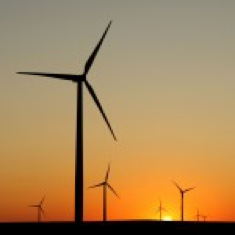One of today’s greatest global challenges is the need for more affordable, reliable, clean, secure and renewable sources of electricity. Relying solely on coal, oil, natural gas and nuclear fuels to generate electricity is far from optimal. Fossil fuels are neither renewable nor clean. Their extraction, transportation and combustion generate air emissions, acid rain, water pollution, and, most importantly, CO₂ emissions that are causing climate change. Moreover, fossil fuel price volatility and supply disruption can wreak havoc on local and national economies. Nuclear energy raises issues of national security and nuclear waste disposal. Wind power diversifies our nation’s energy supply and reduces our dependence on foreign fuel supplies – which helps to strengthen our national security.
Wind power is a commercially proven, rapidly growing form of electricity generation that provides clean, renewable, and cost-effective electricity around the world. There are numerous advantages to using wind to produce electricity.
It’s clean. Wind-generated electricity does not pollute the air, water or soil, does not create acid rain, radioactive waste, or generate CO₂ emissions which contribute to global warming. Additionally, wind power does not consume the large amounts of water needed by other energy sources.
It’s renewable. Wind is the result of daily solar radiation. Unlike fossil fuels, the supply of wind power is unlimited and cannot be depleted. Wind resources are widely distributed throughout the United States.
It’s economical. The price of electricity generated by well-sited wind power plants is competitive with the price of electricity from new fossil fuel plants. The price of wind power is not subject to fuel price increases, supply disruptions, or stricter limits on pollution. The price of fuel (wind) is free. In addition, as governments fight the risks of global warming by imposing a price on carbon emissions, wind power will not be subject to this added cost.
It’s good for rural communities. Wind power helps to diversify the economies of rural communities, adds to the property tax base, and creates highly skilled jobs in construction, operations and maintenance. Wind power supports agriculture by providing supplemental income for farming and ranching families while the land used for wind turbines can continue to be used for farmland and grazing. Developing renewable sources of electricity means importing less fossil fuel from foreign countries, and putting our energy dollars back into the local economy.
It’s compatible with other land uses. Wind turbines and related facilities at a utility-scale wind power plant typically occupy less than 3% of total project land area. The vast majority of land remains free to use in other ways, including ranching, farming, mineral development, hunting, recreation, and many other activities.
It promotes national security and energy independence. Wind energy is homegrown. It cannot be embargoed, and because the wind is free, it is not subject to the dramatic price volatility of fossil fuels. Wind-generated electricity diversifies our energy supply, reduces our dependence on foreign fuels, and reduces the flow of our energy dollars to potentially hostile governments, which increases our national security.
It’s a significant potential energy source for the U.S. A Department of Energy study confirmed the viability and commercial maturity of wind as a major contributor to America’s energy needs, now and in the future. The study concluded that wind energy can produce 20% of U.S. electricity supply by 2030, if the right government policies are put into place. Source: 20% Wind Energy by 2030, US Department of Energy http://www1.eere.energy.gov/windandhydro/pdfs/41869.pdf
It’s fast to install. Large utility-scale wind power plants are routinely built in less than one year. By contrast, most other large power plants take years to construct.
It’s growing rapidly in the U.S. and worldwide. At the end of 2009, there were over 35,000 megawatts (MW) of wind power plants installed in the U.S. That’s enough to power over 9 million homes. Wind power generation in the U.S. grew at an average annual rate of 39% from 2004 through 2009. Worldwide, the growth rate in 2009 was over 31%. These growth rates make wind one of the world’s fastest growing forms of power generation. The State of Iowa now generates over 17% of its electricity from wind, and the State of Texas more than 6%. Internationally, Denmark generates more than 20% of its electricity from wind, Germany generates approximately 7%, and Spain generates in excess of 12%.
